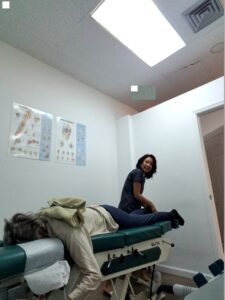
Incredibly, 90 to 95% of diabetics in the United States have type 2 diabetes. This is the type that is able to be reversed or prevented. In fact, Type 2 diabetes may affect as many as 20% of the senior U.S. population (ages 65 to 74 years). Approximately 5.4 million adults in the United States have undiagnosed type 2 diabetes. However, many cases can be avoided by making appropriate lifestyle changes.
In people with diabetes, glucose builds up in the bloodstream leading to hyperglycemia. If it is not properly controlled, diabetes can lead to heart disease, kidney disease, edema, nerve damage, and infections of the mouth, gums, lungs, skin, feet, bladder, and genital areas. And skin sores may develop and fail to heal properly. Chiropractor in West Palm Beach: Diabetes Mellitus and Nutrition is about nutritional supplementation/diet and lifestyle changes to help diabetes mellitus.
Chiropractor in West Palm Beach: What is Diabetes Mellitus?
Diabetes mellitus is a disorder that results in chronic hyperglycemia (high blood sugar) due to absence of insulin, decreases in insulin, and/or decreased sensitivity of insulin receptors (areas on the outer part of a cell that allow the cell to join or bind with insulin that is in the blood). Generally, Diabetes mellitus is evident in two forms: (1) type 1, insulin-dependent diabetes mellitus, and (2) type 2, non-insulin-dependent diabetes mellitus. Usually, type 1 diabetes becomes apparent in childhood or adolescence. And type 2 diabetes shows up later in life (over the age of 40).
Microvascular complications of diabetes are those long-term problematic changes to small blood vessels. Unfortunately, it can lead to various health problems such as: retinopathy (disease of retina of eye), nephropathy (kidney disease), and neuropathy (nerve damage disease).
Moreover, it is estimated that 40% of people in the United States are prediabetic according to the U.S. Centers for Disease Control and Prevention. Also, it appears long-term damage occurs in the pre-diabetic state (especially to the cardiovascular system) prior to the full development of diabetes.
Doctors diagnose diabetes by measuring blood sugar levels. The categories and criteria for diabetes are:
|
Pre-diabetes
|
Diabetes
|
|
-pre-diabetes at 100 mg/dL for a Fasting Plasma Glucose (FPG)
|
-fasting plasma glucose (FPG) level of 126 mg/dL or higher
|
|
-140 mg/dL for an oral glucose tolerance test (2 h PG; OGTT).
|
-a 2-hour plasma glucose (2 h PG; glucose tolerance test) of 200 mg/dL or higher
|
|
|
-patients with apparent signs and symptoms of diabetes with a random plasma glucose concentration of 200 mg/dL or higher
|
Chiropractor in West Palm Beach: PHYSIOLOGY regarding Diabetes Mellitus
Firstly, your Glycemic metabolism is controlled by the interaction of insulin (which has mainly a hypoglycemic/lowers sugar or glucose function) and hormones that are referred to as counterregulatory.
Secondly, these counterregulatory hormones include glucagon (hormone that your pancreas makes to help regulate your blood glucose), epinephrine/norepinephrine (chemical messengers also known as adrenaline, that play an important role in the body’s fight or flight response), cortisol (steroid hormone that is produced by your 2 adrenal glands, helps in immune response and metabolism), and growth hormone (secreted by pituitary and helps metabolism).
Thirdly, in general, these hormones act to stimulate glycogenolysis (happens in the liver and kidney to produce glucose for balancing the blood sugar) and gluconeogenesis (process in the liver when glucose is formed from non-carbohydrate sources).
Fourthly, Catecholamines (e.g. adrenaline) in particular, suppress insulin secretion and stimulate hepatic (liver) glucose production.
Fifthly, the hypoglycemic function of insulin is various. This includes promoting the uptake of glucose by mainly muscle and adipose tissue (fat), inhibiting the breakdown of glycogen (promotes glycogen/”glucose”stores), and inhibiting the production of other sources of energy such as from free fatty acids.
Lastly, Diabetes mellitus is a disorder in which your body does not produce enough or respond normally to insulin, causing blood sugar (glucose) levels to be abnormally high. The body may not produce enough insulin to move the glucose into the cells. Also, the cells may stop responding normally to insulin (insulin resistance). Finally, the resulting high levels of glucose in the blood and the inadequate amount of glucose in the cells together produce the symptoms and complications of diabetes.
Symptoms of diabetes may include:
-increased urination and thirst
-loosing weight even if not trying to
-Diabetes can damage nerves and cause problems with the sense of touch
-Diabetes can damage blood vessels and increase the risk of heart attack, stroke, chronic kidney disease, neuropathy and vision loss.

Chiropractor in West Palm Beach: Risk Factors for Diabetes Mellitus
Type 1 diabetes is an autoimmune reaction (the body attacks itself by mistake). Risk factors include:
- Family history: a parent, brother, or sister with type 1 diabetes.
- Age: While you can get type 1 diabetes at any age, it typically develops in children, teens, or young adults.
Chiropractor in West Palm Beach: Prediabetes and Type 2 Diabetes
So Prediabetes and type 2 diabetes have similar risk factors. To start with, if you already have prediabetes, this is an added risk factor to develop type 2 diabetes. Additional risk factors are:
-Are overweight or obesity.
-Are age 45 or older.
-Your parent or sibling has type 2 diabetes.
-Are physically active less than 3 times a week.
-Have non-alcoholic fatty liver disease
-You had gestational diabetes (diabetes during pregnancy) or given birth to a baby who weighed over 9 pounds.
-Are an African American, Hispanic or Latino, American Indian, or Alaska Native person. Some Pacific Islander people and Asian American people also have a higher risk.
Helpful Supplementation/Nutritional Recommendations for Diabetes Mellitus
Alpha-lipoic acid– may be helpful for peripheral nerve damage in diabetic patients. And helps control blood sugar levels.
Chromium picolinate – may improve glucose tolerance
L-carnitine plus L-glutamine plus taurine– helps mobilize fat, decreases sugar cravings and aides in activating insulin.
Quercetin- protects the eyes from damage due to diabetes
Raw adrenal glandular and raw pancreas glandular and thyroid glandular- Aids in rebuilding and replenishing these organs.
Vitamin B complex – helps improve glucose tolerance
Plus extra Biotin (vitamin B7)- May improve glucose tolerance and reduce pain from diabetic neuropathy.
Inositol– type of hormone like compound. May help improve diabetic neuropathy.
Vitamin B12 plus folic acid- helps diabetic neuropathy
CoenzymeQ-10 plus Coenzyme A– helps glucose tolerance and stabilizes blood sugar.
Magnesium– may improve insulin production
Manganese– may help with repair and metabolism
Psyllium husks– good fiber source and mobilizes fat
Evening Primrose Oil– improves diabetic neuropathy
Aloe Vera Juice- May lower blood sugar levels
D-Vitamin D- Helps maintain good blood flow in patients with diabetes who live in climates where don’t get enough sunshine.
A-Vitamin A with carotenoids– antioxidant that helps the eyes
C-Vitamin C with bioflavonoids-may help slow complications due to diabetes (vascular problems)taken in normal amounts.
E-Vitamin E– helps improve glucose tolerance
Calcium– helps lower the risk of diabetes
Copper complex– helps metabolism. Imbalance of copper may lead to progression of diabetes
Maitake extract– helps with glucose tolerance
Multienzyme complex plus proteolytic enzymes- Good digestion is essential for diabetes recuperation
Pantethine- (Pantothenic acid form) In some studies, pantethine seems to lower levels of cholesterol and triglycerides in people with diabetes.
Pycnogenol or grape seed extract- antioxidant for connective tissue and may help blood sugar levels
Garlic- Enhances immunity and improves circulation.
Gymnema- May help fight sugar cravings and lower high blood sugar
Asian Ginseng- May help with production of insulin and help with activating more insulin receptors
Herbs: Cedar Berries (for the health of the pancreas), Fenugreek seeds (may support blood glucose control), Huckleberry (helps body with protection against diabetes complications), Juniper berries (might help lower blood sugar), dandelion root and uva ursi (for blood sugar levels and clearing of toxins)
Chiropractor in West Palm Beach: Diet/Lifestyle for Diabetes Mellitus
First, Eat a low-fat, high-fiber diet. Be sure to include plenty of raw fruits and vegetables. Fiber helps to reduce blood sugar spikes and keeps you full. Subsequently, oat or rice bran crackers with nut butter or cheese are great between meals. Legumes, root vegetables, and whole grains are additional sources of carbohydrates and protein.
Second, complex carbohydrate intake is important. Similarly, High-glycemic foods such as white rice/ flour products, starchy vegetable (potatoes), and many processed foods are converted into blood sugar during digestion very fast. Your insulin level will spike. Instead, eat Carbohydrates found in low-glycemic foods such as asparagus, broccoli, cabbage, green beans, and low-starch vegetables and fruits. These are converted into blood sugar more slowly (raises insulin levels slowly).
Third, Omit saturated fats, trans fats, hydrogenated or partially hydrogenated oils, and simple sugars (except to balance an insulin reaction). Good fats and oils include extra virgin olive oil, fish oil, almond oil and butter, avocados, nuts, and seed oils such as sesame, flax, sunflower, and pumpkin. Substituting polyunsaturated fats such as these and other vegetable oils also decreases cognitive decline in people with diabetes.
Fourth, among many studies emphasizing the need for exercise in reducing the morbidity (condition of suffering from a disease or medical condition) of diabetes, some indicate minor lifestyle changes may affect mortality (relating to death).
For example, in an 8-week walking program of 10,000 steps/day for women, the benefits of improved glucose tolerance and a reduction in blood pressure was realized.

Chiropractor in West Palm Beach: What is Diabetic Neuropathy?
With Diabetic Neuropathy, you will typically have low back pain along with burning pains in the lower extremities (limbs) and poor balance. Also, it can affect your arms and hands with numbness and pain. Indeed, neuropathy is a diabetes complication that causes nerve damage throughout your body. Hence, about half of all people with diabetes have some form of neuropathy. Furthermore, it is more common in those who have had diabetes for many years.
In one study a patient with diabetic neuropathy was treated with chiropractic manipulation to the intertarsal and mortise joints (foot and ankle joints) and chiropractic myofascial therapy to the quadratus plantae muscles (muscle at bottom of foot) 18 times over 4 months. This treatment brought about dramatic improvement in both symptoms and clinical signs of nerve function. (1)
In conclusion, the study found that joint dysfunction may play a role in susceptibility to diabetic neuropathy and the treatment brought about improvement. Therefore, chiropractic treatment may bring about improvement by normalizing joint and nerve function in the areas affected.
Chiropractor in West Palm Beach: Diabetic Neuropathy
Diabetic Neuropathy can be helped naturally at Meiri Chiropractic. Most certainly, this involves spinal adjustments or extremity (limbs) manipulation and soft tissue techniques along with the use of modalities (i.e. heat therapy, electric muscle stimulation) and rehabilitation/home exercises.
Are you suffering from diabetic neuropathy? As holistic health care professionals, chiropractors are health care providers who discuss and help implement nutritional changes for our patients as well. Your chiropractor in West Palm Beach can help you manage your neuropathy symptoms and improve your overall quality of life. Call 561-253-8984 today!
References: Handbook of Preventative and Therapeutic Nutrition by James M. Gerber,M.S., D.C.
Prescription for Nutritional Healing (3rd edition), Phyllis A. Balch, CNC
Thomas Souza, (2018) Differential Diagnosis and Management for the Chiropractor
*Please consult your doctor (M.D. who is monitoring your condition) about the above supplements.